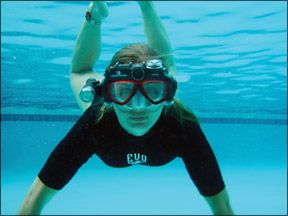For those of us who spend nearly as much time under the water as on it, the Liquid Image 310 video mask sounded like a great addition to our diving kit-and a good fix for our gadget addiction-so we had to give it a try when we came across it at a spring boat show.

The Liquid Image 310 is a snorkel/dive mask with a built-in waterproof digital camera that shoots still photos and video (with audio) in depths up to 65 feet. Other video masks in the Liquid Image line are rated waterproof for 15- to 130-feet deep, and the maker offers accessories like side-mountable flashlights and lens filters to enhance the quality of the photos and videos. The 310, powered by two AAA batteries (Lithium, alkaline, or NiMH), has 16 megabytes of internal memory and accepts microSD cards up to 8 gigabytes. That translates to 11,200 photos or 160 minutes of video.
We tested the 310 mask cam in a freshwater pool after a week of rain left our local waters with the clarity of a milkshake. The camera was very easy to operate with only two buttons-one for power and switching between video and still modes, and the other being the shutter control/video stop-and-start button. The only drawback of the simplified button controls is that they would be challenging to use with gloved hands.
A small LCD in the mask shows mode and power status as well as battery life. Red and blue lights that are visible to the user (but not distracting) and audible beeps let you know when youve switched between modes and when power is on. Crosshairs on each side of the mask lens help users line up the photos/videos but don’t interfere with the view.

Testers really liked the ability to shoot continuous video hands-free, which is not an option with a standard waterproof point-and-shoot. Being able to look at what was around us rather than staring into an LCD to be sure our subject was in the frame was a plus. The downside of not having an LCD viewer was that we had to wait to view our shots until we plugged the mask into our laptop. Even with the crosshairs, framing subjects with the mask cam took some getting used to; all of our shots tended to be lower than we had gauged them.
We pitted the Liquid Image against an Olympus Stylus 1050SW, which is rated to 33 feet, to rate the mask cams image quality and ruggedness. While the 310s video quality was much better than that of its still shots, in our opinion, neither was as high-quality as those taken with the Olympus. We attribute that to the obvious fact the Olympus boasts double the resolution (10.1 megapixels) of the Liquid Image (5 megapixels for stills and 780×420 for video)-but it also costs twice as much. The 310 did seem more rugged than the Olympus, and its waterproofing barriers seem more durable.
The supplied editing software, ArcSoft MediaImpression, lets users tweak photos and videos, and you can even make movies. Testers found it intuitive and easy to use.
Bottom line: If youre looking for a high-quality camera to use on, in, and off the water, this isn’t it. If youre an avid snorkeler or diver, the Liquid Image can be a bargain-we found 310 bundles online for $150 with a 4 gig microSD card and a camera bag-when you consider a good snorkeling mask is $50-plus. The video mask has a simple, rugged digital camera that sailors will enjoy using to document their cruising adventures. Theres nothing like posting a clip of the world below your keel when anchored off Aruba to inspire envy in your social network, and Liquid Image even has a special YouTube area to post mask users underwater videos.







































